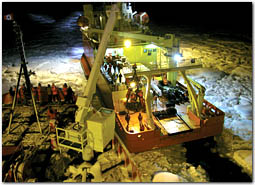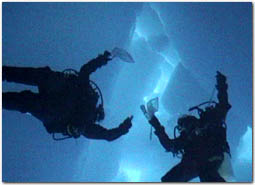 |
Science Highlights > South for the Winter
South for the Winter
 |

Click to enlarge
|
|
Nathaniel B. Palmer, left, and Lawrence M. Gould meet bow to stern in Antarctica’s Marguerite Bay. (Photo by John Higdon) |
Even in the cold darkness of the austral
winter, the Global Ocean Ecosystems Dynamics (GLOBEC) Program continues to shed light on processes that support the ocean’s food chain. Because one of the most thriving biological communities in the world is found in the icy waters of Antarctica, the third phase of GLOBEC is examining the Southern Ocean. Woods Hole Oceanographic Institution (WHOI) Senior Scientist Peter Wiebe led researchers from WHOI and other institutions on two Southern Ocean GLOBEC cruises during 2002, including a rare winter research cruise to the Antarctic. They traveled aboard the National Science Foundation research vessel, Nathaniel B. Palmer.
The Southern Ocean GLOBEC cruises surveyed marine life from microscopic plankton to the largest mammals. Teams biopsied whales, fit seals with satellite tracking devices, and tagged penguins. Other teams catalogued everything caught in nets or captured on high-resolution video aboard the WHOI towed vehicle, BIOMAPER II. But a primary focus of the WHOI research team was the Antarctic krill (Euphausia superba, left), central in the food chain that links single-celled phytoplankton to the top predators. Marguerite Bay, off the Antarctic Peninsula can contain enormous swarms of krill, covering tens of square kilometers and forming a vast banquet for whales, seals, and penguins. Although much is known about the life cycle of krill, little is known about how it survives long, frigid, winters in the ice-covered ocean. Preliminary data indicated a level of nutrients in the water column and under the sea ice similar to that found in 2001. But the team found that larval krill were less abundant than in 2001, so questions remain about relative reproductive success, competitors for food, and larval distribution. Because krill typically live under the sea ice in winter, researchers must don dive suits and use small plankton nets to collect specimens for laboratory studies.
 |

Click to enlarge
|
|
Melanie Parker and Kerri Scolardi, of the University of South Florida, collect juvenile krill under the ice. (Photo by Stian Alesandrini) |
As part of the effort to understand the environment that harbors such an abundance of life, the Southern Ocean GLOBEC cruises also collected data about the conductivity, temperature, density, and fluorescence of seawater; took meteorological measurements; and sampled sea ice in all its forms. The 2002 cruises encountered far more pack ice and icebergs than in 2001, which prevented the ships from returning to Marguerite Bay in August, forcing them to work farther offshore. The early and rapid freeze-up occurred during the second-coldest May, with temperatures averaging -11.5°C (11.3°F) and the coldest June, averaging -19°C (-2.2°F), since air temperature record keeping began in 1977 at Rothera, the nearby British Antarctic research base.
GLOBEC cruises were funded by the National Science Foundation, and some data analysis was funded by the National Oceanic and Atmospheric Administration, via the WHOI Cooperative Institute for Climate and Ocean Research.
|
